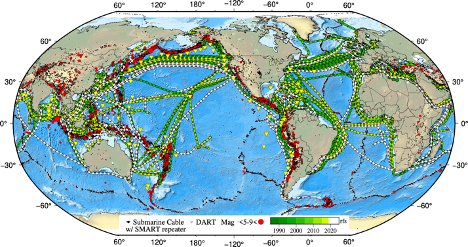To subscribe to the ORE seminar mailing list, click here.
For a (working draft) list of upcoming seminars, click here.
If you are interested in giving an ORE seminar, please contact us at nosal [at] hawaii [dot] edu.
Seminar: Fluid-Structure Interactions in Offshore Engineering
Deniz Gedikli, PhD Assistant Professor Department of Ocean and Resources Engineering University of Hawai’i, Mānoa Technology, law and world’s appetite for more energy pushed oil-gas and renewable energy source exploration farther from the shores. Recent developments in this search have brought additional design challenges since these large offshore structures are more prone to the harsh environments around them. These factors require innovative approaches, in part because companies cannot operate in conventional ways in the Arctic region and in deep sea. This topic has critical importance to the offshore industry, particularly for the cost-effective development of new ocean structures such as
Seminar: Recent Operations, Findings, and Plans at the Wave Energy Test Site (WETS)
Patrick Cross, PhD Senior Project Specialist Hawai'i Natural Energy Institute The U.S. Navy’s Wave Energy Test Site (WETS) has been operational in its final configuration since June 2015. The site has now hosted four separate wave energy converter (WEC) deployments - two each of two different WECs. Several other commercial WEC deployments are planned over the next few years. HNEI provides research and logistics support to WETS, including independent device performance monitoring, environmental measurements, site infrastructure inspection and maintenance, outfitting of a site-dedicated vessel, liaison with companies planning tests, and other support as needed by the Navy sponsor. In this
Seminar: ORE Student Presentations
Andi Erickson, Nicholas Ulm, Giannicola Tumino Di Costanzo, Julianne Kalksma, Shijie Huang, Kei Manabe, Cameron Morrow, David Leyva, Stefan Mrozewski Nine ORE graduate students will present as part of our new ORE seminar session “Improving effective communication skills”. Each student will present their research work or interest in about 3 minutes to a targeted audience. Topics include: El Niño southern oscillation, powering blue economy, ultra-short base line, photography for coastal research, multi-flow simulation, detecting spinner dolphin clicks, analysis of mooring line fatigue, choosing appropriate buoys for long-term time-series analysis, and factors affecting underwater laser Transmission. The targeted audience ranges from
MS Plan A Defense: Uncertainties of multi-decadal buoy and altimeter observations
David Leyva The impacts of climate change are evident globally. Changes to the sea state, including ocean wave heights, are important for the long-term design of ocean resources and management. Previous studies estimate multi-decadal wave height trends from satellite altimetry and wave buoy observations but they do not robustly quantify uncertainties in trends. Changes in buoy hulls, payloads, and processing may influence year-to-year variability in buoy time series and create spurious climate signals. We find that standard approaches to identify step-changes in buoy time series are highly dependent on the reference time series. This is because identifying step-changes is most
MS Plan A Defense: Relationships between tsunami size and earthquake magnitude improved by fault parameters
Lin SUN. Megathrust earthquakes are the main source of tsunamis. The rupture at the plate interface deforms the seafloor, displacing seawater over a large region. The earthquake magnitude is not the only factor that affects the tsunami amplitude. A tsunami earthquake, which produces a much larger tsunami than what can be inferred from the seismic energy release, exemplifies this phenomenon. This thesis examines relationships between tsunami size and key geophysical attributes such as fault depth, fault dip, fault size, rigidity, and water depth besides moment magnitude. The parametric study involves four sets of simplified megathrust-ocean models and utilizes an elastic
Seminar: Honolulu Living Shorelines: Resilience and Connectivity by Design
Judith Stilgenbauer, ASLA Professor & Master of Landscape Architecture Program Director School of Architecture University of Hawai'i at Mānoa The applied design research presented in this seminar highlights the role of landscape architecture and large-scale green infrastructure systems in the creation of flood-resilient urban waterfronts. Focusing on three flood-prone catalytic sites, all located in Honolulu’s primary urban center, the presentation visualizes speculative long-term design proposals that introduce nature-based, “soft” coastal adaptation strategies aimed to decrease waterfront vulnerabilities. More broadly, this guest lecture advocates for the anticipation of coastal climate challenges, such as multi-hazard flooding in near-shore development, through innovative ecological
Seminar: Micro-rosette: a novel means of sampling for autonomous platforms
Ellen Briggs, PhD Assistant Professor Department of Ocean & Resources Engineering University of Hawai'i at Mānoa We have been developing a ‘micro-rosette’ for collecting water samples on mobile platforms such as profiling floats. Not all sensing technologies can measure at the rate required for mobile platforms so here we use this micro-rosette to collect and store samples to be measured at a later time. For Argo-style profiling floats, there is a ~9-day park cycle between profiles during which the sample analyses can be completed. The original aim was to measure DIC (dissolved inorganic carbon) through a method using a gas
Seminar: Regional Scale Numerical Modeling of Wave Propagation and Transformation in Icy Waters – Capabilities and Challenges
Hongtao Li, PhD Centre for Sustainable Arctic Marine and Coastal Technology Department of Civil and Environmental Engineering Norwegian University of Science and Technology (NTNU), Trondheim, Norway In the past several decades, it has been observed obvious diminishing trend of ice cover in the polar regions. This opens the possibility for using Northern Sea route all year round. Nevertheless, with the retreat of ice cover, the fetch for waves to grow also increases. Consequently, wave climate deteriorates in both Arctic and Antarctic. In the meantime, the human activities in these regions such as fishing, tourism as well as exploration of hydrocarbon
Seminar: Honouliuli Wastewater Outfall Alternatives Evaluation
Dr. Dayananda Vithanage Director of Engineering, Oceanit *Abstract is not yet available.* ***Please join us ten minutes early for a virtual coffee hour hosted by Dr. Deniz Gedikli.*** Join Zoom Meeting Meeting ID: 958 5874 1165 Passcode: 545601
Seminar: SMART Subsea Cables for Observing the Ocean and Earth: An Update
Bruce Howe Ocean and Resources Engineering School of Ocean and Earth Science and Technology University of Hawaii at Manoa JTF SMART Subsea Cables (Joint Task Force, Science Monitoring And Reliable Telecommunications, 1) is working to integrate environmental sensors for ocean bottom temperature, pressure and seismic acceleration into submarine telecommunications cables. The purpose of SMART Cables is supporting climate and ocean observation, sea level monitoring, observations of Earth structure, and tsunami and earthquake early warning and disaster risk reduction. Recent advances include regional SMART pilot systems that are the first steps to trans-ocean and global implementation. Building on the OceanObs’19 conference
Seminar: Fluid-Structure Interactions: From Fundamentals of Flow-induced Vibration to Applications in Energy Harvesting
Banafsheh Seyed-Aghazadeh, PhD Mechanical Engineering Department, University of Massachusetts, Dartmouth When a flexible or flexibly-mounted structure is placed in fluid flow, it can deform or oscillate. The deformation or oscillation of the structure will result in the change of flow forces, which in turn will result in the change of the structure’s deformation or oscillation. This is called a Fluid-Structure Interactions (FSI) problem and the oscillation is called Flow-Induced Vibration (FIV). FIV has significant implications for a number of physical systems, from aeolian harps to power transmission lines, towing cables, undersea pipelines, drilling risers and mooring lines used to stabilize
Experiments and Interpretation of Ice-Induced Vibrations of Offshore Structures
Dr. Torodd Nord Associate Professor Department of Ocean Operations and Civil Engineering Norwegian University of Science and Technology (NTNU) When drifting sea ice interacts with a structure, it may result in structural vibrations hence ice-induced vibration. With the potential to harm the structural integrity, secondary installations and operational safety, ice-induced vibration is an important problem that needs to be addressed in structural design. Since the first deployment of Arctic offshore platforms in Cook Inlet, Alaska in 1960s, extensive measurement campaigns have brought significant attention and knowledge to ice-induced vibrations. With today’s growing demand for renewable energy, the development of offshore


